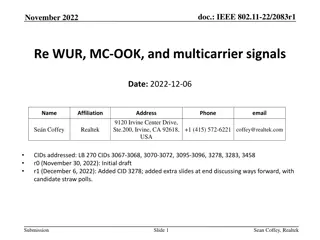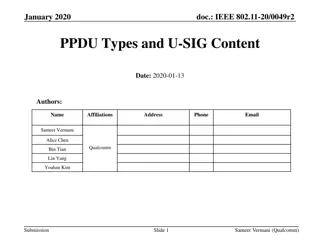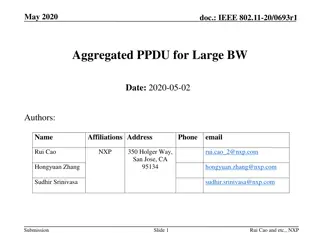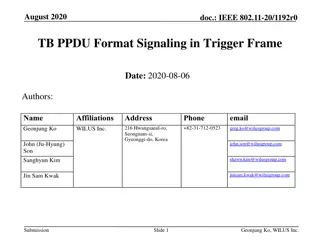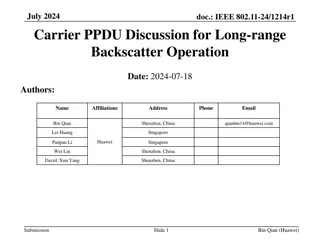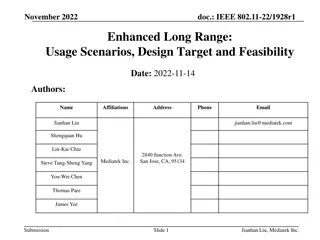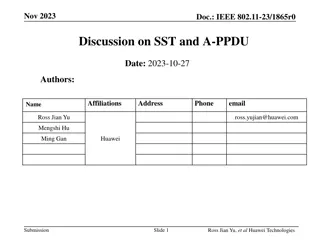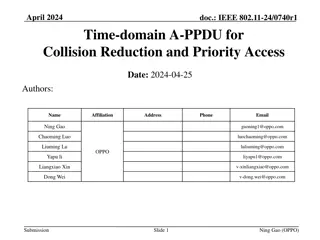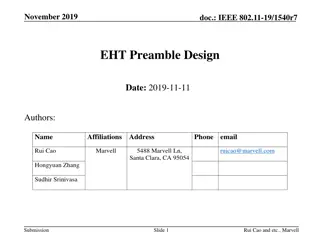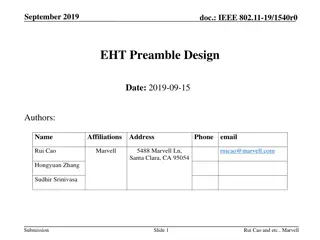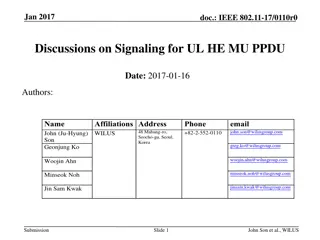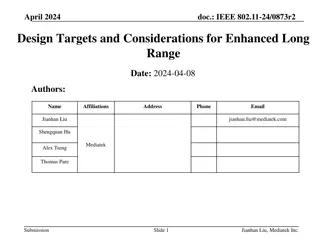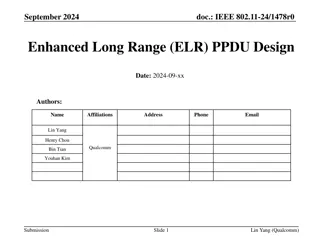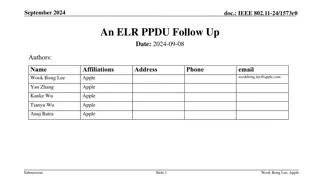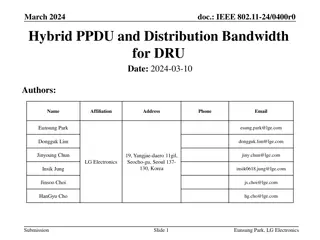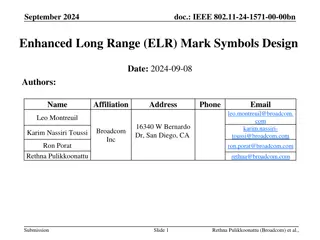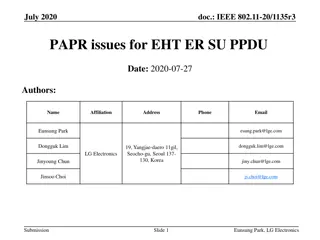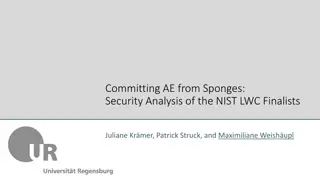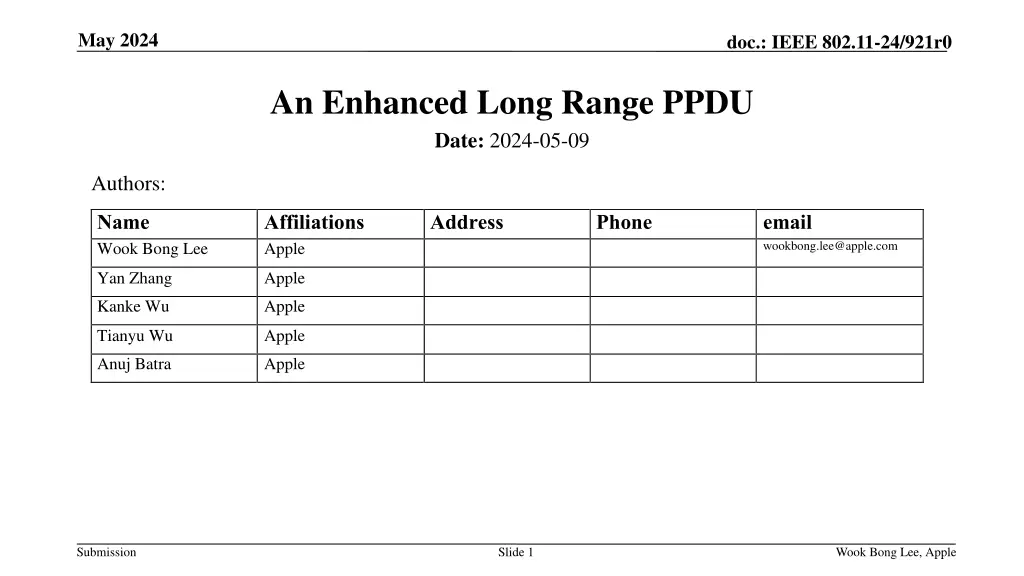
Enhanced Long Range PPDU in IEEE 802.11-24
Explore the advancement in long-range PPDU technology within IEEE 802.11-24, addressing transmit power differences, antenna configurations, packet detection methods, and feasibility studies. Discover insights on UORA, Triggered Access, and more in this informative document from Apple.
Download Presentation

Please find below an Image/Link to download the presentation.
The content on the website is provided AS IS for your information and personal use only. It may not be sold, licensed, or shared on other websites without obtaining consent from the author. If you encounter any issues during the download, it is possible that the publisher has removed the file from their server.
You are allowed to download the files provided on this website for personal or commercial use, subject to the condition that they are used lawfully. All files are the property of their respective owners.
The content on the website is provided AS IS for your information and personal use only. It may not be sold, licensed, or shared on other websites without obtaining consent from the author.
E N D
Presentation Transcript
May 2024 doc.: IEEE 802.11-24/921r0 An Enhanced Long Range PPDU Date: 2024-05-09 Authors: Name Wook Bong Lee Affiliations Apple Address Phone email wookbong.lee@apple.com Yan Zhang Apple Kanke Wu Apple Tianyu Wu Apple Anuj Batra Apple Submission Slide 1 Wook Bong Lee, Apple
May 2024 doc.: IEEE 802.11-24/921r0 Introduction In a typical scenario, a non-AP STA s transmit power is about 10 dB lower than that of an AP STA Due to regulation: different transmit power restriction for an AP STA and a non-AP STA Due to implementation: an AP STA s PA could be better than a non-AP STA s PA (need to lower Tx power to meet Tx requirement) An AP STA may have more antennas than a non-AP STA: e.g. an AP STA with 4 antenna, a non-AP STA with 2 antenna This gives 6 dB link budget difference between downlink and uplink (10 dB transmit power difference can be closed by 6 dB link budget improvement + 3 dB from antenna and 1 dB from more diversity gain from more antennas) FCC Indoor AP Non-AP STA 5.15-5.25 GHz 5.725-5.895 GHz 30 dBm and 17 dBm / MHz 36 dBm and 20 dBm / MHz 24 dBm and 11 dBm / MHz 30 dBm and 14 dBm / MHz Can we improve/reduce 10 dB transmit power or 6 dB link budget difference? Submission Slide 2 Wook Bong Lee, Apple
May 2024 doc.: IEEE 802.11-24/921r0 Packet Detection Each STA need to check channel idle within a slot time (more specifically within aCCATime) It is desired to perform packet detection based on the first field of a PPDU (e.g. L-STF) which is less than a slot time aSlotTime is 9 us and a STA needs to determine CCA busy or not within aCCATime, thus the packet detection shall be finished within L-STF (< 8 us) aSlotTime is 9us for 5 and 6 GHz and 20us for 2.4 GHz Submission Slide 3 Wook Bong Lee, Apple
May 2024 doc.: IEEE 802.11-24/921r0 Feasibility Study Channel D, non ideal CHE, packet detection, CFO Assumption A non-AP STA has two antennas An AP STA has four antennas Real packet detection based on L- STF An ELR PPDU is transmitted with some preprocessing 100 10-1 PER An ELR PPDU can perform 10 dB better than a non-HT PPDU at 10% PER 10-2 NON HT 4x2 NON HT 2x4 ELR 2x4 -16 -14 -12 -10 -8 -6 -4 -2 0 2 SNR Different Relative to Non HT 4x2 [dB] Wook Bong Lee, Apple Submission Slide 4
May 2024 doc.: IEEE 802.11-24/921r0 Discussion: UORA and Triggered Access Why not using UORA? UORA is developed in 802.11ax but it is barely seen in products due to its low airtime efficiency EHT group has decided not to expand it for 320 MHz due to similar reasons There will be a lot of delay when the transmission fails due to collision in UORA case Why not always using Triggered Access? AP implementations can vary quite a lot, from high-end to low-end, and depending on the AP implementation, we may prefer to use UL Trigger, and in other cases, we may prefer to use EDCA Triggered access should not be the only transmission alternative for the STA. EDCA needs to be available too, EDCA has been always used together with triggered access Some frames can t be triggered, e.g. Immediate response frames such as ACK Probe Request, Association Request as unassociated STA does not have STA-ID Trigger involves unnecessary overhead and delay for some short frames E.g. QoS Null with PM bits (30 B, ~ 200 us) Submission Slide 5 Wook Bong Lee, Apple
May 2024 doc.: IEEE 802.11-24/921r0 Conclusion In this contribution, we proposed to define an uplink enhanced long range (ELR) PPDU Improving uplink link budget in all 2.4/5/6 GHz bands by 6 dB We showed that 6 dB uplink link budget improvement can be achieved without a long preamble When a number of antennas at an AP STA is twice more than that of a non-AP STA, a required SNR for an ELR PPDU can be 10 dB less than that of a non-HT PPDU MCS0 In other words, we can close the gap between downlink and uplink link budget Submission Slide 6 Wook Bong Lee, Apple
May 2024 doc.: IEEE 802.11-24/921r0 SP Do you agree to design an Enhanced Long Range (ELR) PPDU in IEEE 802.11bn with target as below? Uplink in 2.4 GHz, 5 GHz and 6 GHz Minimum data rate is higher than 1.5Mbps Submission Slide 7 Wook Bong Lee, Apple



